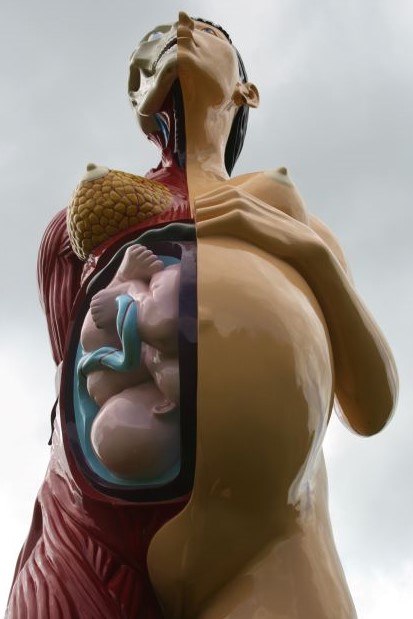
This is Damien Hirst's 'The Virgin Mother' at Yorkshire Sculpture Park a few months ago. I'd always thought it was just a bit overblown and kitsch and a rip-off of anatomical models, but now seeing it in a new light after reading Mary Joan Winn Leith's analysis in her book 'The Virgin Mary' in the 'a very short introduction' series. Everything from the nudity to the nipples gets a link to Marian symbolism!
Comments
New comment
Thought I should add in some of the links that Leith makes...
‘…what Hirst has created with The Virgin Mother is a complex sermon about Mary that challenges believers to confront the implications of essential Christian beliefs’
Nudity: her pregnant nudity pronounces Mary free from original sin – Mary is the New Eve. After ‘the Fall’ nudity symbolises humanity’s shame, if Mary is the New Eve and participating in the restoration of human perfection through Christ her nudity shows that conditions have been reset to the original form that God created. As Eve was naked before God, Mary’s nudity shows there are again no barriers to intimacy with the divine.
Precedents to showing a foetal Jesus – Byzantine art icons – 12th C images of Annunciation and Visitation.
A physical, visceral Jesus foetus emphasises the challenge of God ‘incarnate’ – literally flesh-wrapped. ‘Lifelike flesh and blood foreshadow the price Jesus and his mother are fated to play’
Divinity from God, humanity from Mary
Hirst’s accentuation of the breasts aligns with emphasis given to the observation that Jesus suckled at his mother’s breasts. 7th century artists produced images of the Virgin breast feeding, flourished as a symbol until supressed by Council of Trent
Breasts symbolised Mary’s power of intercession – ‘as Jesus drew life from her breasts he could not deny her requests’
Milk from Mary’s breasts were powerful relics, Henry VIII and Katherine of Aragon made pilgrimage to shrine of Walsingham where altar held a vial of Mary’s milk
Youth of sculpture – Council of Trent mandated that Mary be girl of 12 or 13, youth was seen as ‘purity’.
Size of sculpture - recalls other enormous Mary statues erected since mid-20th century – ‘giant-sized Mary statues are often right-wing declarations of resistance to Vatican II’ – (Leith also makes point that Virgin has close association with anti-Communism in Cold War and this may contribute to the relationship)
Links with other monumental Goddess statues – ancient virgin goddess Athena in Parthenon. Massive size indicates power and recalls invincible virgin warrior of the walls of Constantinople